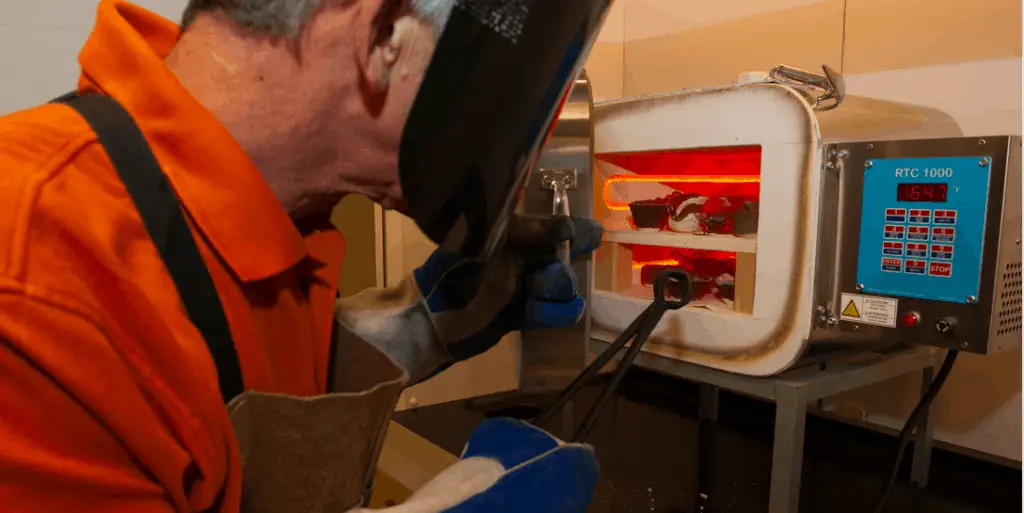When choosing kilns, sometimes you learn that a ceramic kiln is a little bit different from the rest. But what are they, and what is a ceramic kiln used for?
You’re about to find out. In this, we’ll tell you what is a ceramic kiln, and what are some of the benefits of a ceramic kiln and why some people consider this type.

These Change Pottery to Ceramics
The idea of pottery and ceramics being the same thing is actually not correct. There are a few differences between pottery and ceramics, and you’ll learn about them here
- Pottery essentially fires pots to stay in the same composition and shape
- With ceramics, other chemical actions happen as the water dries up
- Usually, this results in the glassy, almost smooth feeling that ceramics has
- It also can handle multiple different clay bodies
So a ceramic kiln has the full purpose of creating ceramics, which involve multiple different chemical changes that you and your pieces can benefit from.
It also can handle other jobs too, especially any small actions and tasks regarding the way pottery is finished.
These get hot!
Unlike other types of drying mediums, these get hot. Now, I’m not talking like maybe a thousand or so degrees, I’m talking much more than that.
Some features of kilns are that they tend to be made for hotter pottery, and that’s because of the following:
- Most of the clays that you use need to be fired at minimally 2000 degrees
- You need at least 1600 degrees for pottery to start turning into ceramics
- It involves the process of changing the clay properties, which means that you need a higher temperature for the pottery
- If you plan to either bisque fire or glaze fire, you need to fire it between 1657-2kiln degrees Fahrenheit, maybe hotter.
So, if you’re planning to fire pottery, you’ll be able to do it by using a ceramics kiln, which in turn will allow for it to get hot enough that it will work, and it will use the right properties that will allow for the clay to move from one property to another.
If you’re planning on firing this, you might think that having the temperature go over 2000 degrees is too much, but the thing is, these kilns are tested, and they are certified to handle these comfortable temperatures, and it will handle them much better.

These tend to handle different types of Clay
There are many different types of clay that can be fired in a ceramic kiln, and they are as follows:
- Porcelain which is a high-firing clay that is durable, strong, and vitreous, and is pure white and has a lot of kaolin in it
- Stoneware which is mid and high-firing that is coarse-grained clay body that can be buff to grey to dark brown because of the iron and other impurities
- Earthenware which is grey, orange, or red in color, and is rawer
Ceramic kilns can handle all three of these, but other kilns may not do so. Ceramic kilns allow for many people to fire clays at a higher temperature than others, which in turn will allow you to handle more and more clays.
Loading and unloading tips for This
Loading these types of kilns can be quite different too, since they do need to factor a couple of elements that are in this, including the following:
- How much they are spaced
- How they are of varying heights
When you load a kiln, you’ll be able to process the items by different heights and shapes. If you group the tables at different heights, or even just having them at different heights can help.
Loading involves a few following aspects, and they are the following:
- An inch of space between the shelves and walls
- Space bottom shelf an inch from the floor
- Allow a couple of spaces between the lids and the closest from the items on the top
- Keep most items a few inches from one another so that they don’t thermocouple which can cause false readings
- Offset the shelves with a staggered pattern
- You can also dome the lid
With ceramic kilns, this involves a lot more, simply because you are making sure that they get enough space for them to dry, and also because if you don’t fire these properly, it can cause some major issues over time.
Unloading is just as important, and while you might be anxious to see what happens, you should make sure that you never unload a ceramic kiln too fast. When you unload, do the following:
- Wait until it’s room temperature
- Let it sit and slowly dry
- Never let this dry super fast, since they can explode
- Waiting a little bit longer will allow you to get the most out of this
Ceramic kilns do involve this, since lots of times, you’ll be able to prevent the ceramics from firing improperly.
They are a bit pricey
Ceramic kilns are well, pricey and there are a few reasons for that to happen. The reason being is that ceramic kilns involve a few different changes, and they are as follows:
- They are bigger
- Temperature controls are more exact
- They tend to be in certain shapes for loading and unloading
- They typically can fire to higher temperatures
That is a huge part of these kilns, and they are something that you should make sure that you keep in mind when choosing the kiln that you want.
Ceramic Kilns get the job done!
If you’re a potter looking to get the most out of your pottery skills, then you should definitely consider getting a ceramic kiln. They offer a variety of different benefits that allow you to make a variety of pieces as well.
When you choose a kiln, definitely consider this type of kiln too.







